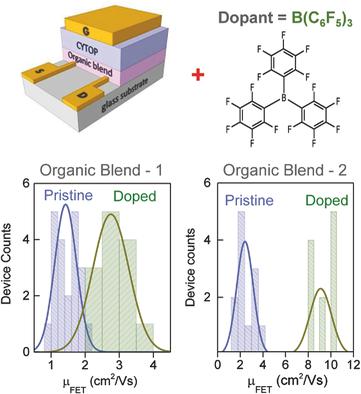Our official English website, www.x-mol.net, welcomes your
feedback! (Note: you will need to create a separate account there.)
Remarkable Enhancement of the Hole Mobility in Several Organic Small‐Molecules, Polymers, and Small‐Molecule:Polymer Blend Transistors by Simple Admixing of the Lewis Acid p‐Dopant B(C6F5)3
Advanced Science ( IF 14.3 ) Pub Date : 2017-10-05 , DOI: 10.1002/advs.201700290 Julianna Panidi 1 , Alexandra F Paterson 1 , Dongyoon Khim 1 , Zhuping Fei 2 , Yang Han 2 , Leonidas Tsetseris 3 , George Vourlias 4 , Panos A Patsalas 4 , Martin Heeney 2 , Thomas D Anthopoulos 1, 5
Advanced Science ( IF 14.3 ) Pub Date : 2017-10-05 , DOI: 10.1002/advs.201700290 Julianna Panidi 1 , Alexandra F Paterson 1 , Dongyoon Khim 1 , Zhuping Fei 2 , Yang Han 2 , Leonidas Tsetseris 3 , George Vourlias 4 , Panos A Patsalas 4 , Martin Heeney 2 , Thomas D Anthopoulos 1, 5
Affiliation

|
Improving the charge carrier mobility of solution‐processable organic semiconductors is critical for the development of advanced organic thin‐film transistors and their application in the emerging sector of printed electronics. Here, a simple method is reported for enhancing the hole mobility in a wide range of organic semiconductors, including small‐molecules, polymers, and small‐molecule:polymer blends, with the latter systems exhibiting the highest mobility. The method is simple and relies on admixing of the molecular Lewis acid B(C6F5)3 in the semiconductor formulation prior to solution deposition. Two prototypical semiconductors where B(C6F5)3 is shown to have a remarkable impact are the blends of 2,8‐difluoro‐5,11‐bis(triethylsilylethynyl)anthradithiophene:poly(triarylamine) (diF‐TESADT:PTAA) and 2,7‐dioctyl[1]‐benzothieno[3,2‐b][1]benzothiophene:poly(indacenodithiophene‐co‐benzothiadiazole) (C8‐BTBT:C16‐IDTBT), for which hole mobilities of 8 and 11 cm2 V−1 s−1, respectively, are obtained. Doping of the 6,13‐bis(triisopropylsilylethynyl)pentacene:PTAA blend with B(C6F5)3 is also shown to increase the maximum hole mobility to 3.7 cm2 V−1 s−1. Analysis of the single and multicomponent materials reveals that B(C6F5)3 plays a dual role, first acting as an efficient p‐dopant, and secondly as a microstructure modifier. Semiconductors that undergo simultaneous p‐doping and dopant‐induced long‐range crystallization are found to consistently outperform transistors based on the pristine materials. Our work underscores Lewis acid doping as a generic strategy towards high performance printed organic microelectronics.
中文翻译:

通过简单混合路易斯酸 p-掺杂剂 B(C6F5)3 显着增强几种有机小分子、聚合物和小分子:聚合物混合晶体管中的空穴迁移率
提高可溶液加工的有机半导体的载流子迁移率对于先进有机薄膜晶体管的开发及其在印刷电子新兴领域的应用至关重要。在这里,报道了一种简单的方法,用于增强各种有机半导体中的空穴迁移率,包括小分子、聚合物和小分子:聚合物共混物,后者系统表现出最高的迁移率。该方法很简单,并且依赖于在溶液沉积之前将分子路易斯酸B(C 6 F 5 ) 3混合在半导体配方中。B(C 6 F 5 ) 3表现出显着影响的两种典型半导体是 2,8-二氟-5,11-双(三乙基甲硅烷基乙炔基)蒽并噻吩:聚(三芳基胺) (diF-TESADT:PTAA) 的混合物和2,7-二辛基[1]-苯并噻吩[3,2-b][1]苯并噻吩:聚(茚并二噻吩-苯并噻二唑)(C8-BTBT:C16-IDTBT),其空穴迁移率分别为8和11 cm分别获得2 V -1 s -1 。6,13-双(三异丙基甲硅烷基乙炔基)并五苯:PTAA混合物与B(C 6 F 5 ) 3的掺杂也被证明可将最大空穴迁移率提高至3.7 cm 2 V -1 s -1。对单组分和多组分材料的分析表明,B(C 6 F 5 ) 3具有双重作用,首先作为有效的 p 掺杂剂,其次作为微结构改性剂。人们发现,同时进行 p 掺杂和掺杂剂诱导的长程结晶的半导体的性能始终优于基于原始材料的晶体管。我们的工作强调路易斯酸掺杂作为高性能印刷有机微电子学的通用策略。
更新日期:2017-10-05
中文翻译:

通过简单混合路易斯酸 p-掺杂剂 B(C6F5)3 显着增强几种有机小分子、聚合物和小分子:聚合物混合晶体管中的空穴迁移率
提高可溶液加工的有机半导体的载流子迁移率对于先进有机薄膜晶体管的开发及其在印刷电子新兴领域的应用至关重要。在这里,报道了一种简单的方法,用于增强各种有机半导体中的空穴迁移率,包括小分子、聚合物和小分子:聚合物共混物,后者系统表现出最高的迁移率。该方法很简单,并且依赖于在溶液沉积之前将分子路易斯酸B(C 6 F 5 ) 3混合在半导体配方中。B(C 6 F 5 ) 3表现出显着影响的两种典型半导体是 2,8-二氟-5,11-双(三乙基甲硅烷基乙炔基)蒽并噻吩:聚(三芳基胺) (diF-TESADT:PTAA) 的混合物和2,7-二辛基[1]-苯并噻吩[3,2-b][1]苯并噻吩:聚(茚并二噻吩-苯并噻二唑)(C8-BTBT:C16-IDTBT),其空穴迁移率分别为8和11 cm分别获得2 V -1 s -1 。6,13-双(三异丙基甲硅烷基乙炔基)并五苯:PTAA混合物与B(C 6 F 5 ) 3的掺杂也被证明可将最大空穴迁移率提高至3.7 cm 2 V -1 s -1。对单组分和多组分材料的分析表明,B(C 6 F 5 ) 3具有双重作用,首先作为有效的 p 掺杂剂,其次作为微结构改性剂。人们发现,同时进行 p 掺杂和掺杂剂诱导的长程结晶的半导体的性能始终优于基于原始材料的晶体管。我们的工作强调路易斯酸掺杂作为高性能印刷有机微电子学的通用策略。











































 京公网安备 11010802027423号
京公网安备 11010802027423号